Reflected Best Self Analysis: Positive Psychology and RBS Exercise
VerifiedAdded on 2023/01/19
|22
|5151
|76
Report
AI Summary
This report presents a comprehensive analysis of the Reflected Best Self (RBS) exercise within the framework of positive psychology. The student begins with a critical literature review, defining positive psychology, tracing its origins to figures like Martin Seligman and Maslow, and discussing its core concepts, including the pleasant life, the good life, and the meaningful life. The review also addresses criticisms of positive psychology, such as its sole focus on positive aspects and its componential approach. The RBS exercise is then detailed, outlining the methodology of gathering feedback from individuals, identifying themes, and creating a self-best vision statement. The student sent out emails to gather feedback and analyzed the results, identifying key themes and creating a self-best vision statement. The report incorporates feedback from various sources (family, friends, and colleagues) to create a portrait of the student at their best, using the insights to develop a vision of strengths and potential. The report highlights the benefits of the RBS exercise in building confidence and enhancing performance.
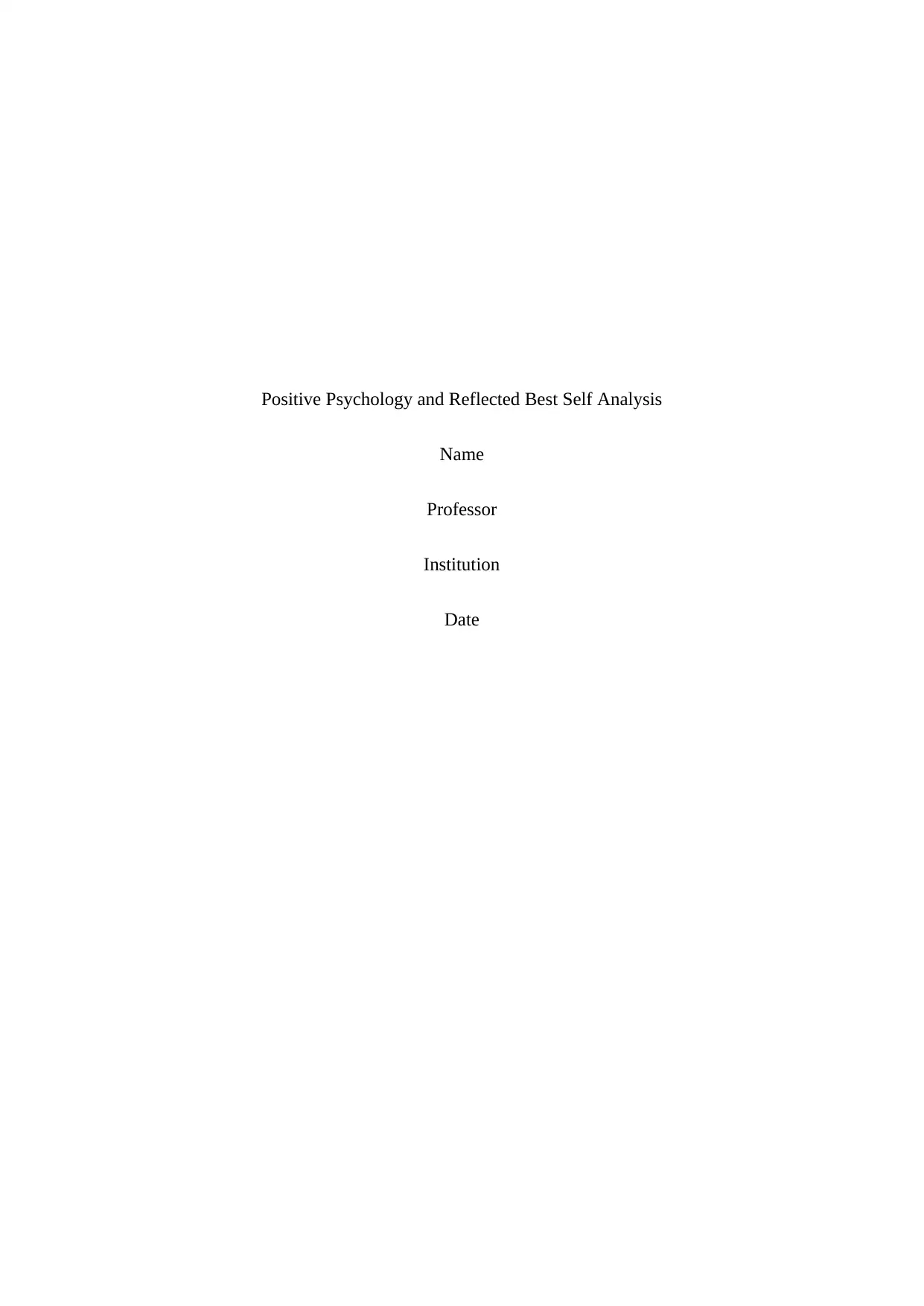
Positive Psychology and Reflected Best Self Analysis
Name
Professor
Institution
Date
Name
Professor
Institution
Date
Paraphrase This Document
Need a fresh take? Get an instant paraphrase of this document with our AI Paraphraser
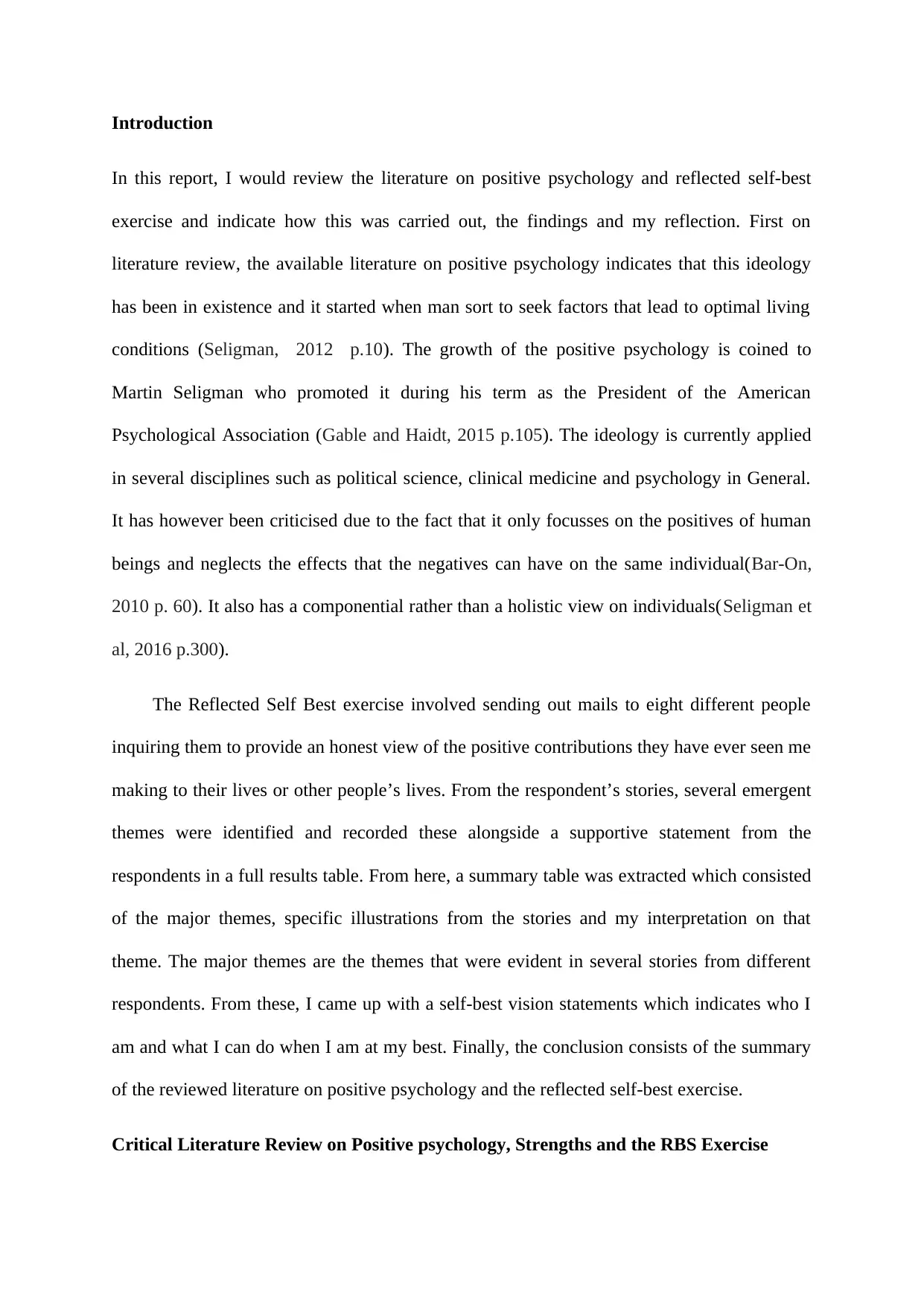
Introduction
In this report, I would review the literature on positive psychology and reflected self-best
exercise and indicate how this was carried out, the findings and my reflection. First on
literature review, the available literature on positive psychology indicates that this ideology
has been in existence and it started when man sort to seek factors that lead to optimal living
conditions (Seligman, 2012 p.10). The growth of the positive psychology is coined to
Martin Seligman who promoted it during his term as the President of the American
Psychological Association (Gable and Haidt, 2015 p.105). The ideology is currently applied
in several disciplines such as political science, clinical medicine and psychology in General.
It has however been criticised due to the fact that it only focusses on the positives of human
beings and neglects the effects that the negatives can have on the same individual(Bar-On,
2010 p. 60). It also has a componential rather than a holistic view on individuals(Seligman et
al, 2016 p.300).
The Reflected Self Best exercise involved sending out mails to eight different people
inquiring them to provide an honest view of the positive contributions they have ever seen me
making to their lives or other people’s lives. From the respondent’s stories, several emergent
themes were identified and recorded these alongside a supportive statement from the
respondents in a full results table. From here, a summary table was extracted which consisted
of the major themes, specific illustrations from the stories and my interpretation on that
theme. The major themes are the themes that were evident in several stories from different
respondents. From these, I came up with a self-best vision statements which indicates who I
am and what I can do when I am at my best. Finally, the conclusion consists of the summary
of the reviewed literature on positive psychology and the reflected self-best exercise.
Critical Literature Review on Positive psychology, Strengths and the RBS Exercise
In this report, I would review the literature on positive psychology and reflected self-best
exercise and indicate how this was carried out, the findings and my reflection. First on
literature review, the available literature on positive psychology indicates that this ideology
has been in existence and it started when man sort to seek factors that lead to optimal living
conditions (Seligman, 2012 p.10). The growth of the positive psychology is coined to
Martin Seligman who promoted it during his term as the President of the American
Psychological Association (Gable and Haidt, 2015 p.105). The ideology is currently applied
in several disciplines such as political science, clinical medicine and psychology in General.
It has however been criticised due to the fact that it only focusses on the positives of human
beings and neglects the effects that the negatives can have on the same individual(Bar-On,
2010 p. 60). It also has a componential rather than a holistic view on individuals(Seligman et
al, 2016 p.300).
The Reflected Self Best exercise involved sending out mails to eight different people
inquiring them to provide an honest view of the positive contributions they have ever seen me
making to their lives or other people’s lives. From the respondent’s stories, several emergent
themes were identified and recorded these alongside a supportive statement from the
respondents in a full results table. From here, a summary table was extracted which consisted
of the major themes, specific illustrations from the stories and my interpretation on that
theme. The major themes are the themes that were evident in several stories from different
respondents. From these, I came up with a self-best vision statements which indicates who I
am and what I can do when I am at my best. Finally, the conclusion consists of the summary
of the reviewed literature on positive psychology and the reflected self-best exercise.
Critical Literature Review on Positive psychology, Strengths and the RBS Exercise
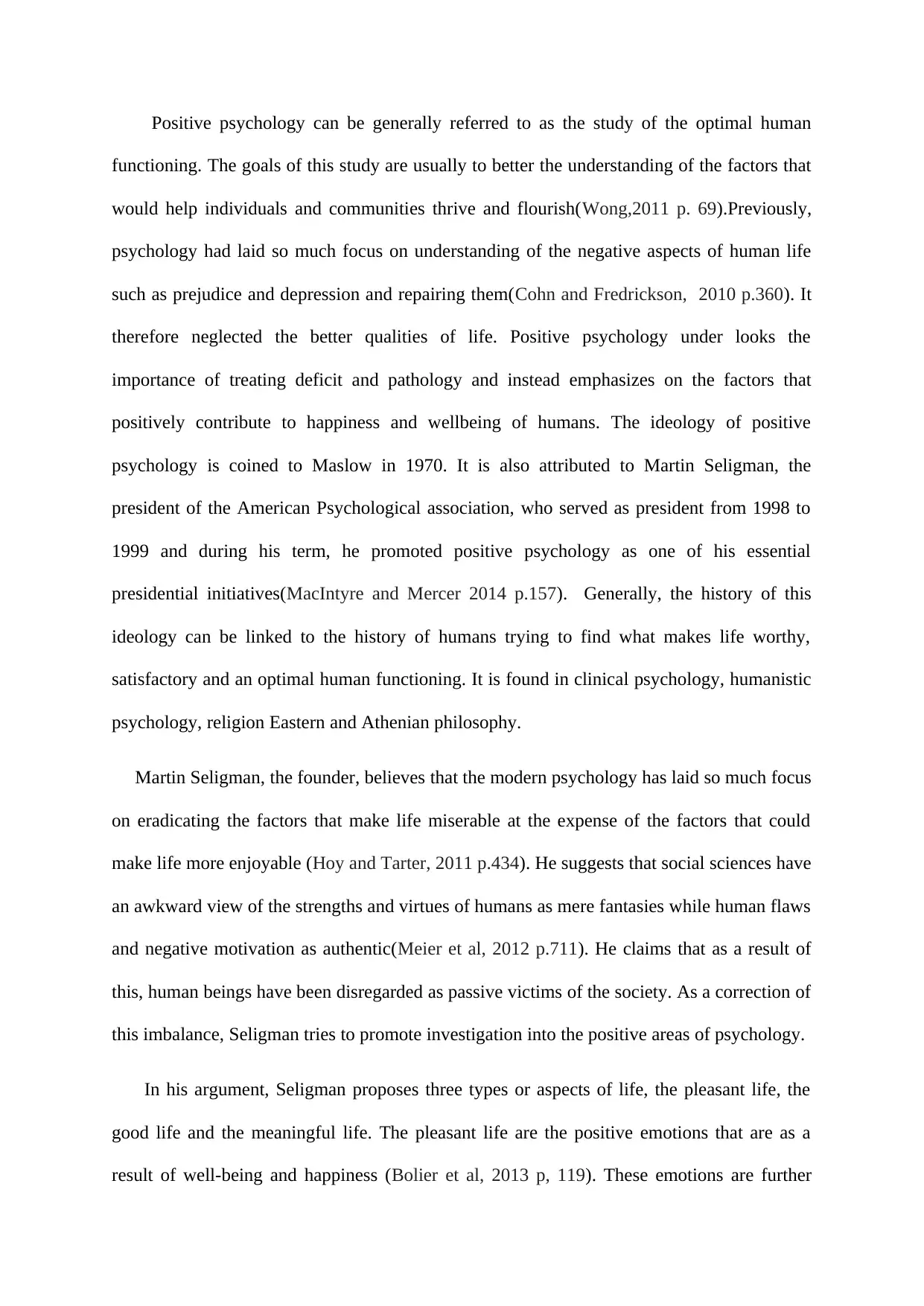
Positive psychology can be generally referred to as the study of the optimal human
functioning. The goals of this study are usually to better the understanding of the factors that
would help individuals and communities thrive and flourish(Wong,2011 p. 69).Previously,
psychology had laid so much focus on understanding of the negative aspects of human life
such as prejudice and depression and repairing them(Cohn and Fredrickson, 2010 p.360). It
therefore neglected the better qualities of life. Positive psychology under looks the
importance of treating deficit and pathology and instead emphasizes on the factors that
positively contribute to happiness and wellbeing of humans. The ideology of positive
psychology is coined to Maslow in 1970. It is also attributed to Martin Seligman, the
president of the American Psychological association, who served as president from 1998 to
1999 and during his term, he promoted positive psychology as one of his essential
presidential initiatives(MacIntyre and Mercer 2014 p.157). Generally, the history of this
ideology can be linked to the history of humans trying to find what makes life worthy,
satisfactory and an optimal human functioning. It is found in clinical psychology, humanistic
psychology, religion Eastern and Athenian philosophy.
Martin Seligman, the founder, believes that the modern psychology has laid so much focus
on eradicating the factors that make life miserable at the expense of the factors that could
make life more enjoyable (Hoy and Tarter, 2011 p.434). He suggests that social sciences have
an awkward view of the strengths and virtues of humans as mere fantasies while human flaws
and negative motivation as authentic(Meier et al, 2012 p.711). He claims that as a result of
this, human beings have been disregarded as passive victims of the society. As a correction of
this imbalance, Seligman tries to promote investigation into the positive areas of psychology.
In his argument, Seligman proposes three types or aspects of life, the pleasant life, the
good life and the meaningful life. The pleasant life are the positive emotions that are as a
result of well-being and happiness (Bolier et al, 2013 p, 119). These emotions are further
functioning. The goals of this study are usually to better the understanding of the factors that
would help individuals and communities thrive and flourish(Wong,2011 p. 69).Previously,
psychology had laid so much focus on understanding of the negative aspects of human life
such as prejudice and depression and repairing them(Cohn and Fredrickson, 2010 p.360). It
therefore neglected the better qualities of life. Positive psychology under looks the
importance of treating deficit and pathology and instead emphasizes on the factors that
positively contribute to happiness and wellbeing of humans. The ideology of positive
psychology is coined to Maslow in 1970. It is also attributed to Martin Seligman, the
president of the American Psychological association, who served as president from 1998 to
1999 and during his term, he promoted positive psychology as one of his essential
presidential initiatives(MacIntyre and Mercer 2014 p.157). Generally, the history of this
ideology can be linked to the history of humans trying to find what makes life worthy,
satisfactory and an optimal human functioning. It is found in clinical psychology, humanistic
psychology, religion Eastern and Athenian philosophy.
Martin Seligman, the founder, believes that the modern psychology has laid so much focus
on eradicating the factors that make life miserable at the expense of the factors that could
make life more enjoyable (Hoy and Tarter, 2011 p.434). He suggests that social sciences have
an awkward view of the strengths and virtues of humans as mere fantasies while human flaws
and negative motivation as authentic(Meier et al, 2012 p.711). He claims that as a result of
this, human beings have been disregarded as passive victims of the society. As a correction of
this imbalance, Seligman tries to promote investigation into the positive areas of psychology.
In his argument, Seligman proposes three types or aspects of life, the pleasant life, the
good life and the meaningful life. The pleasant life are the positive emotions that are as a
result of well-being and happiness (Bolier et al, 2013 p, 119). These emotions are further
⊘ This is a preview!⊘
Do you want full access?
Subscribe today to unlock all pages.

Trusted by 1+ million students worldwide
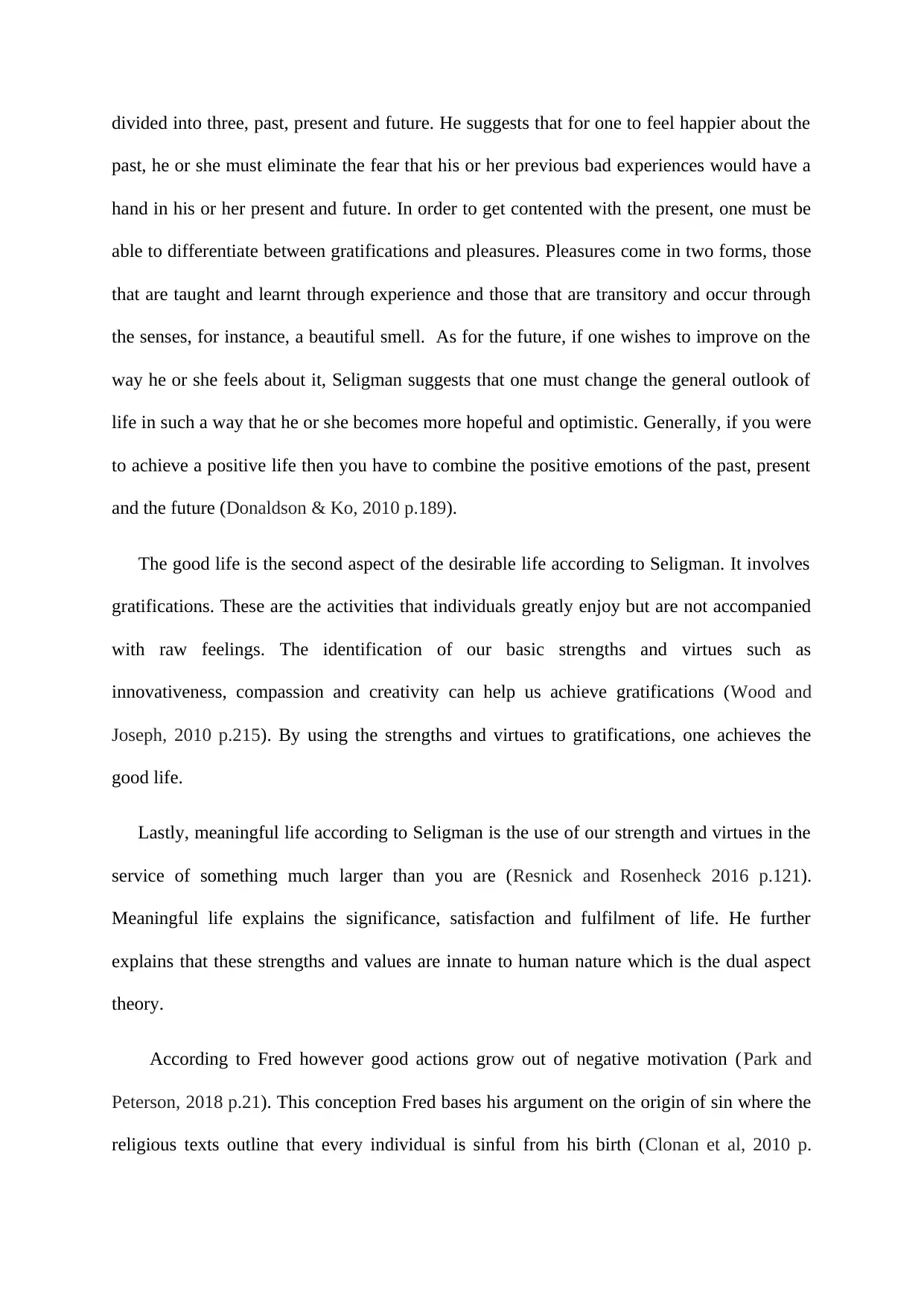
divided into three, past, present and future. He suggests that for one to feel happier about the
past, he or she must eliminate the fear that his or her previous bad experiences would have a
hand in his or her present and future. In order to get contented with the present, one must be
able to differentiate between gratifications and pleasures. Pleasures come in two forms, those
that are taught and learnt through experience and those that are transitory and occur through
the senses, for instance, a beautiful smell. As for the future, if one wishes to improve on the
way he or she feels about it, Seligman suggests that one must change the general outlook of
life in such a way that he or she becomes more hopeful and optimistic. Generally, if you were
to achieve a positive life then you have to combine the positive emotions of the past, present
and the future (Donaldson & Ko, 2010 p.189).
The good life is the second aspect of the desirable life according to Seligman. It involves
gratifications. These are the activities that individuals greatly enjoy but are not accompanied
with raw feelings. The identification of our basic strengths and virtues such as
innovativeness, compassion and creativity can help us achieve gratifications (Wood and
Joseph, 2010 p.215). By using the strengths and virtues to gratifications, one achieves the
good life.
Lastly, meaningful life according to Seligman is the use of our strength and virtues in the
service of something much larger than you are (Resnick and Rosenheck 2016 p.121).
Meaningful life explains the significance, satisfaction and fulfilment of life. He further
explains that these strengths and values are innate to human nature which is the dual aspect
theory.
According to Fred however good actions grow out of negative motivation (Park and
Peterson, 2018 p.21). This conception Fred bases his argument on the origin of sin where the
religious texts outline that every individual is sinful from his birth (Clonan et al, 2010 p.
past, he or she must eliminate the fear that his or her previous bad experiences would have a
hand in his or her present and future. In order to get contented with the present, one must be
able to differentiate between gratifications and pleasures. Pleasures come in two forms, those
that are taught and learnt through experience and those that are transitory and occur through
the senses, for instance, a beautiful smell. As for the future, if one wishes to improve on the
way he or she feels about it, Seligman suggests that one must change the general outlook of
life in such a way that he or she becomes more hopeful and optimistic. Generally, if you were
to achieve a positive life then you have to combine the positive emotions of the past, present
and the future (Donaldson & Ko, 2010 p.189).
The good life is the second aspect of the desirable life according to Seligman. It involves
gratifications. These are the activities that individuals greatly enjoy but are not accompanied
with raw feelings. The identification of our basic strengths and virtues such as
innovativeness, compassion and creativity can help us achieve gratifications (Wood and
Joseph, 2010 p.215). By using the strengths and virtues to gratifications, one achieves the
good life.
Lastly, meaningful life according to Seligman is the use of our strength and virtues in the
service of something much larger than you are (Resnick and Rosenheck 2016 p.121).
Meaningful life explains the significance, satisfaction and fulfilment of life. He further
explains that these strengths and values are innate to human nature which is the dual aspect
theory.
According to Fred however good actions grow out of negative motivation (Park and
Peterson, 2018 p.21). This conception Fred bases his argument on the origin of sin where the
religious texts outline that every individual is sinful from his birth (Clonan et al, 2010 p.
Paraphrase This Document
Need a fresh take? Get an instant paraphrase of this document with our AI Paraphraser
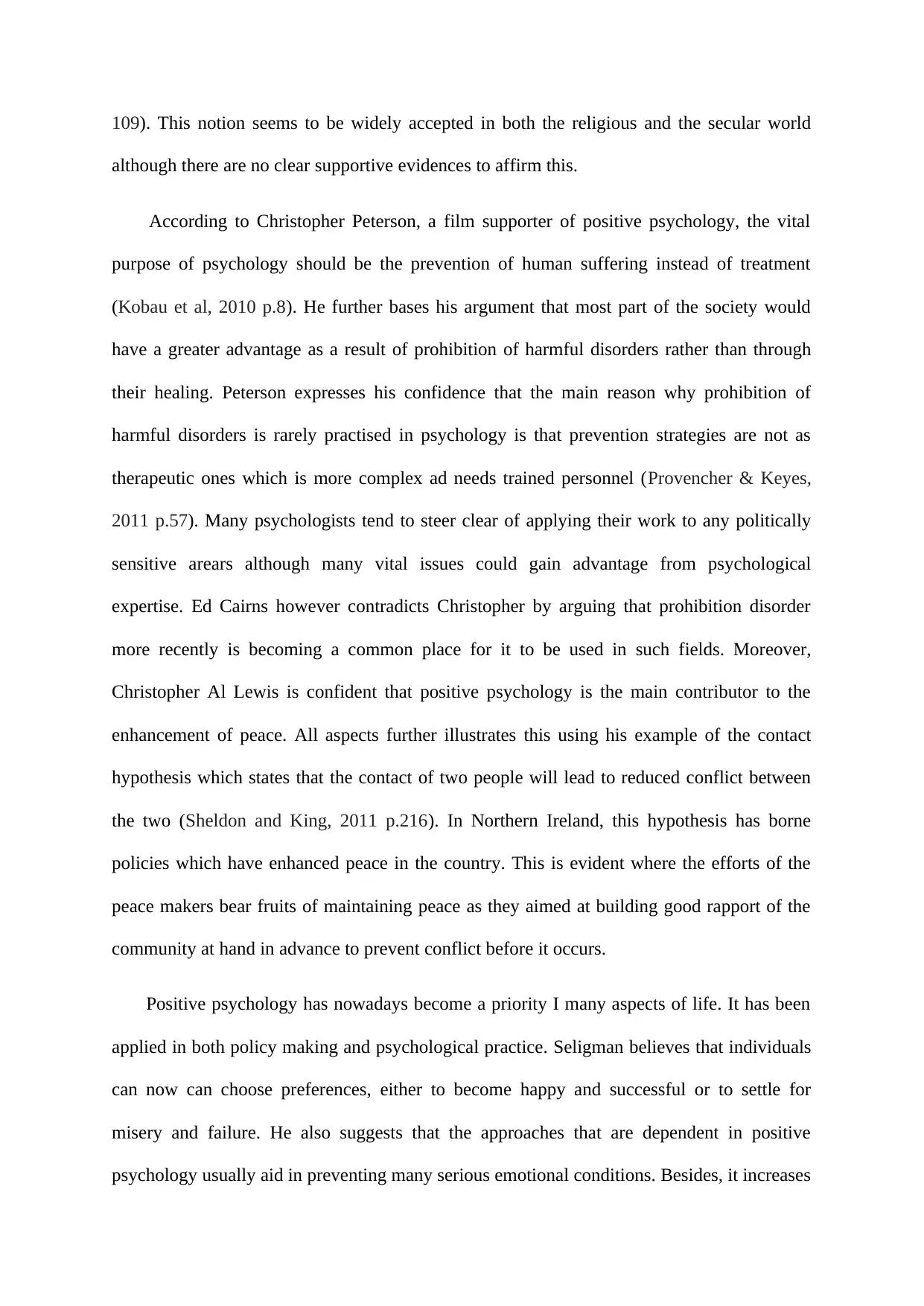
109). This notion seems to be widely accepted in both the religious and the secular world
although there are no clear supportive evidences to affirm this.
According to Christopher Peterson, a film supporter of positive psychology, the vital
purpose of psychology should be the prevention of human suffering instead of treatment
(Kobau et al, 2010 p.8). He further bases his argument that most part of the society would
have a greater advantage as a result of prohibition of harmful disorders rather than through
their healing. Peterson expresses his confidence that the main reason why prohibition of
harmful disorders is rarely practised in psychology is that prevention strategies are not as
therapeutic ones which is more complex ad needs trained personnel (Provencher & Keyes,
2011 p.57). Many psychologists tend to steer clear of applying their work to any politically
sensitive arears although many vital issues could gain advantage from psychological
expertise. Ed Cairns however contradicts Christopher by arguing that prohibition disorder
more recently is becoming a common place for it to be used in such fields. Moreover,
Christopher Al Lewis is confident that positive psychology is the main contributor to the
enhancement of peace. All aspects further illustrates this using his example of the contact
hypothesis which states that the contact of two people will lead to reduced conflict between
the two (Sheldon and King, 2011 p.216). In Northern Ireland, this hypothesis has borne
policies which have enhanced peace in the country. This is evident where the efforts of the
peace makers bear fruits of maintaining peace as they aimed at building good rapport of the
community at hand in advance to prevent conflict before it occurs.
Positive psychology has nowadays become a priority I many aspects of life. It has been
applied in both policy making and psychological practice. Seligman believes that individuals
can now can choose preferences, either to become happy and successful or to settle for
misery and failure. He also suggests that the approaches that are dependent in positive
psychology usually aid in preventing many serious emotional conditions. Besides, it increases
although there are no clear supportive evidences to affirm this.
According to Christopher Peterson, a film supporter of positive psychology, the vital
purpose of psychology should be the prevention of human suffering instead of treatment
(Kobau et al, 2010 p.8). He further bases his argument that most part of the society would
have a greater advantage as a result of prohibition of harmful disorders rather than through
their healing. Peterson expresses his confidence that the main reason why prohibition of
harmful disorders is rarely practised in psychology is that prevention strategies are not as
therapeutic ones which is more complex ad needs trained personnel (Provencher & Keyes,
2011 p.57). Many psychologists tend to steer clear of applying their work to any politically
sensitive arears although many vital issues could gain advantage from psychological
expertise. Ed Cairns however contradicts Christopher by arguing that prohibition disorder
more recently is becoming a common place for it to be used in such fields. Moreover,
Christopher Al Lewis is confident that positive psychology is the main contributor to the
enhancement of peace. All aspects further illustrates this using his example of the contact
hypothesis which states that the contact of two people will lead to reduced conflict between
the two (Sheldon and King, 2011 p.216). In Northern Ireland, this hypothesis has borne
policies which have enhanced peace in the country. This is evident where the efforts of the
peace makers bear fruits of maintaining peace as they aimed at building good rapport of the
community at hand in advance to prevent conflict before it occurs.
Positive psychology has nowadays become a priority I many aspects of life. It has been
applied in both policy making and psychological practice. Seligman believes that individuals
can now can choose preferences, either to become happy and successful or to settle for
misery and failure. He also suggests that the approaches that are dependent in positive
psychology usually aid in preventing many serious emotional conditions. Besides, it increases
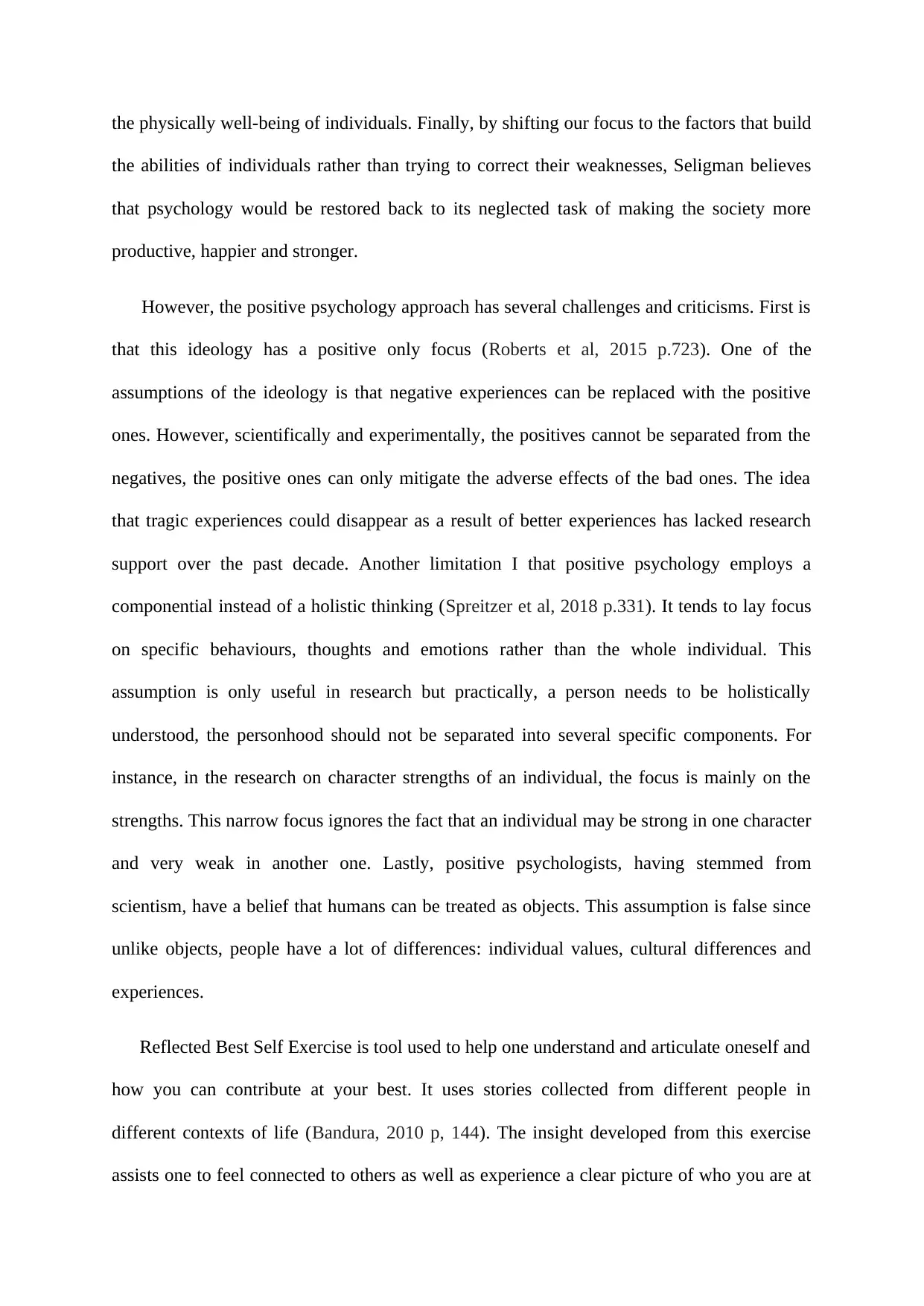
the physically well-being of individuals. Finally, by shifting our focus to the factors that build
the abilities of individuals rather than trying to correct their weaknesses, Seligman believes
that psychology would be restored back to its neglected task of making the society more
productive, happier and stronger.
However, the positive psychology approach has several challenges and criticisms. First is
that this ideology has a positive only focus (Roberts et al, 2015 p.723). One of the
assumptions of the ideology is that negative experiences can be replaced with the positive
ones. However, scientifically and experimentally, the positives cannot be separated from the
negatives, the positive ones can only mitigate the adverse effects of the bad ones. The idea
that tragic experiences could disappear as a result of better experiences has lacked research
support over the past decade. Another limitation I that positive psychology employs a
componential instead of a holistic thinking (Spreitzer et al, 2018 p.331). It tends to lay focus
on specific behaviours, thoughts and emotions rather than the whole individual. This
assumption is only useful in research but practically, a person needs to be holistically
understood, the personhood should not be separated into several specific components. For
instance, in the research on character strengths of an individual, the focus is mainly on the
strengths. This narrow focus ignores the fact that an individual may be strong in one character
and very weak in another one. Lastly, positive psychologists, having stemmed from
scientism, have a belief that humans can be treated as objects. This assumption is false since
unlike objects, people have a lot of differences: individual values, cultural differences and
experiences.
Reflected Best Self Exercise is tool used to help one understand and articulate oneself and
how you can contribute at your best. It uses stories collected from different people in
different contexts of life (Bandura, 2010 p, 144). The insight developed from this exercise
assists one to feel connected to others as well as experience a clear picture of who you are at
the abilities of individuals rather than trying to correct their weaknesses, Seligman believes
that psychology would be restored back to its neglected task of making the society more
productive, happier and stronger.
However, the positive psychology approach has several challenges and criticisms. First is
that this ideology has a positive only focus (Roberts et al, 2015 p.723). One of the
assumptions of the ideology is that negative experiences can be replaced with the positive
ones. However, scientifically and experimentally, the positives cannot be separated from the
negatives, the positive ones can only mitigate the adverse effects of the bad ones. The idea
that tragic experiences could disappear as a result of better experiences has lacked research
support over the past decade. Another limitation I that positive psychology employs a
componential instead of a holistic thinking (Spreitzer et al, 2018 p.331). It tends to lay focus
on specific behaviours, thoughts and emotions rather than the whole individual. This
assumption is only useful in research but practically, a person needs to be holistically
understood, the personhood should not be separated into several specific components. For
instance, in the research on character strengths of an individual, the focus is mainly on the
strengths. This narrow focus ignores the fact that an individual may be strong in one character
and very weak in another one. Lastly, positive psychologists, having stemmed from
scientism, have a belief that humans can be treated as objects. This assumption is false since
unlike objects, people have a lot of differences: individual values, cultural differences and
experiences.
Reflected Best Self Exercise is tool used to help one understand and articulate oneself and
how you can contribute at your best. It uses stories collected from different people in
different contexts of life (Bandura, 2010 p, 144). The insight developed from this exercise
assists one to feel connected to others as well as experience a clear picture of who you are at
⊘ This is a preview!⊘
Do you want full access?
Subscribe today to unlock all pages.

Trusted by 1+ million students worldwide
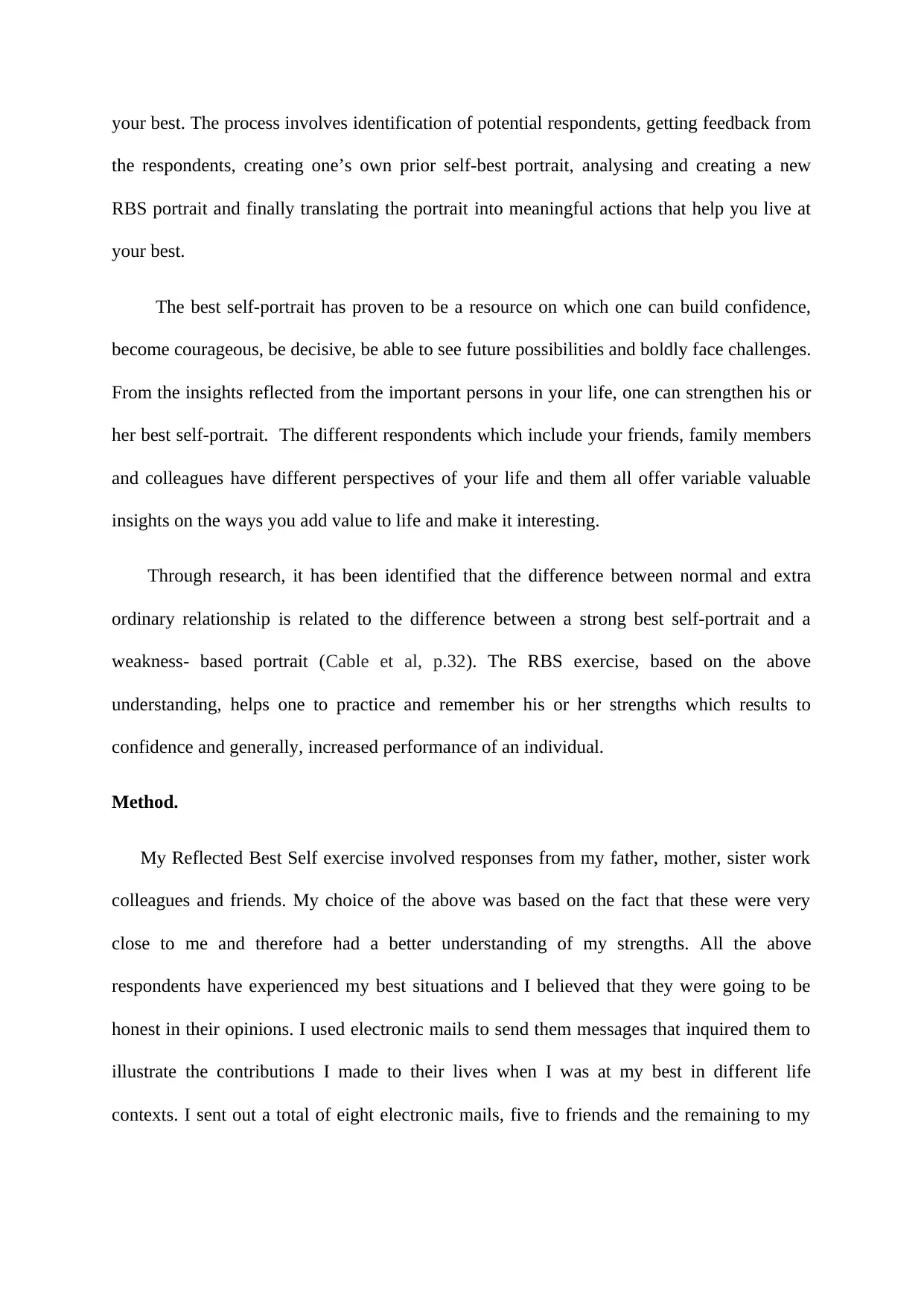
your best. The process involves identification of potential respondents, getting feedback from
the respondents, creating one’s own prior self-best portrait, analysing and creating a new
RBS portrait and finally translating the portrait into meaningful actions that help you live at
your best.
The best self-portrait has proven to be a resource on which one can build confidence,
become courageous, be decisive, be able to see future possibilities and boldly face challenges.
From the insights reflected from the important persons in your life, one can strengthen his or
her best self-portrait. The different respondents which include your friends, family members
and colleagues have different perspectives of your life and them all offer variable valuable
insights on the ways you add value to life and make it interesting.
Through research, it has been identified that the difference between normal and extra
ordinary relationship is related to the difference between a strong best self-portrait and a
weakness- based portrait (Cable et al, p.32). The RBS exercise, based on the above
understanding, helps one to practice and remember his or her strengths which results to
confidence and generally, increased performance of an individual.
Method.
My Reflected Best Self exercise involved responses from my father, mother, sister work
colleagues and friends. My choice of the above was based on the fact that these were very
close to me and therefore had a better understanding of my strengths. All the above
respondents have experienced my best situations and I believed that they were going to be
honest in their opinions. I used electronic mails to send them messages that inquired them to
illustrate the contributions I made to their lives when I was at my best in different life
contexts. I sent out a total of eight electronic mails, five to friends and the remaining to my
the respondents, creating one’s own prior self-best portrait, analysing and creating a new
RBS portrait and finally translating the portrait into meaningful actions that help you live at
your best.
The best self-portrait has proven to be a resource on which one can build confidence,
become courageous, be decisive, be able to see future possibilities and boldly face challenges.
From the insights reflected from the important persons in your life, one can strengthen his or
her best self-portrait. The different respondents which include your friends, family members
and colleagues have different perspectives of your life and them all offer variable valuable
insights on the ways you add value to life and make it interesting.
Through research, it has been identified that the difference between normal and extra
ordinary relationship is related to the difference between a strong best self-portrait and a
weakness- based portrait (Cable et al, p.32). The RBS exercise, based on the above
understanding, helps one to practice and remember his or her strengths which results to
confidence and generally, increased performance of an individual.
Method.
My Reflected Best Self exercise involved responses from my father, mother, sister work
colleagues and friends. My choice of the above was based on the fact that these were very
close to me and therefore had a better understanding of my strengths. All the above
respondents have experienced my best situations and I believed that they were going to be
honest in their opinions. I used electronic mails to send them messages that inquired them to
illustrate the contributions I made to their lives when I was at my best in different life
contexts. I sent out a total of eight electronic mails, five to friends and the remaining to my
Paraphrase This Document
Need a fresh take? Get an instant paraphrase of this document with our AI Paraphraser
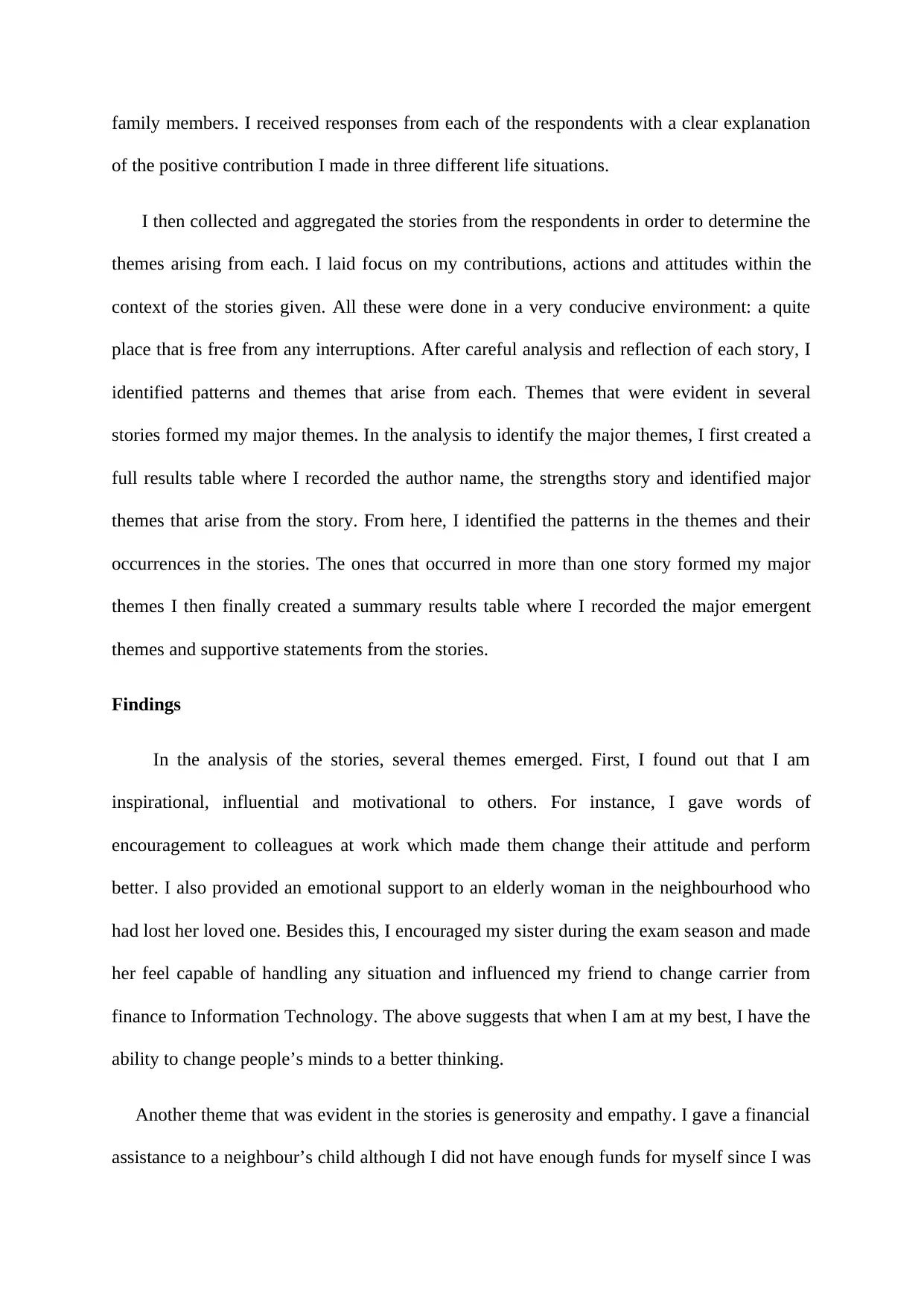
family members. I received responses from each of the respondents with a clear explanation
of the positive contribution I made in three different life situations.
I then collected and aggregated the stories from the respondents in order to determine the
themes arising from each. I laid focus on my contributions, actions and attitudes within the
context of the stories given. All these were done in a very conducive environment: a quite
place that is free from any interruptions. After careful analysis and reflection of each story, I
identified patterns and themes that arise from each. Themes that were evident in several
stories formed my major themes. In the analysis to identify the major themes, I first created a
full results table where I recorded the author name, the strengths story and identified major
themes that arise from the story. From here, I identified the patterns in the themes and their
occurrences in the stories. The ones that occurred in more than one story formed my major
themes I then finally created a summary results table where I recorded the major emergent
themes and supportive statements from the stories.
Findings
In the analysis of the stories, several themes emerged. First, I found out that I am
inspirational, influential and motivational to others. For instance, I gave words of
encouragement to colleagues at work which made them change their attitude and perform
better. I also provided an emotional support to an elderly woman in the neighbourhood who
had lost her loved one. Besides this, I encouraged my sister during the exam season and made
her feel capable of handling any situation and influenced my friend to change carrier from
finance to Information Technology. The above suggests that when I am at my best, I have the
ability to change people’s minds to a better thinking.
Another theme that was evident in the stories is generosity and empathy. I gave a financial
assistance to a neighbour’s child although I did not have enough funds for myself since I was
of the positive contribution I made in three different life situations.
I then collected and aggregated the stories from the respondents in order to determine the
themes arising from each. I laid focus on my contributions, actions and attitudes within the
context of the stories given. All these were done in a very conducive environment: a quite
place that is free from any interruptions. After careful analysis and reflection of each story, I
identified patterns and themes that arise from each. Themes that were evident in several
stories formed my major themes. In the analysis to identify the major themes, I first created a
full results table where I recorded the author name, the strengths story and identified major
themes that arise from the story. From here, I identified the patterns in the themes and their
occurrences in the stories. The ones that occurred in more than one story formed my major
themes I then finally created a summary results table where I recorded the major emergent
themes and supportive statements from the stories.
Findings
In the analysis of the stories, several themes emerged. First, I found out that I am
inspirational, influential and motivational to others. For instance, I gave words of
encouragement to colleagues at work which made them change their attitude and perform
better. I also provided an emotional support to an elderly woman in the neighbourhood who
had lost her loved one. Besides this, I encouraged my sister during the exam season and made
her feel capable of handling any situation and influenced my friend to change carrier from
finance to Information Technology. The above suggests that when I am at my best, I have the
ability to change people’s minds to a better thinking.
Another theme that was evident in the stories is generosity and empathy. I gave a financial
assistance to a neighbour’s child although I did not have enough funds for myself since I was
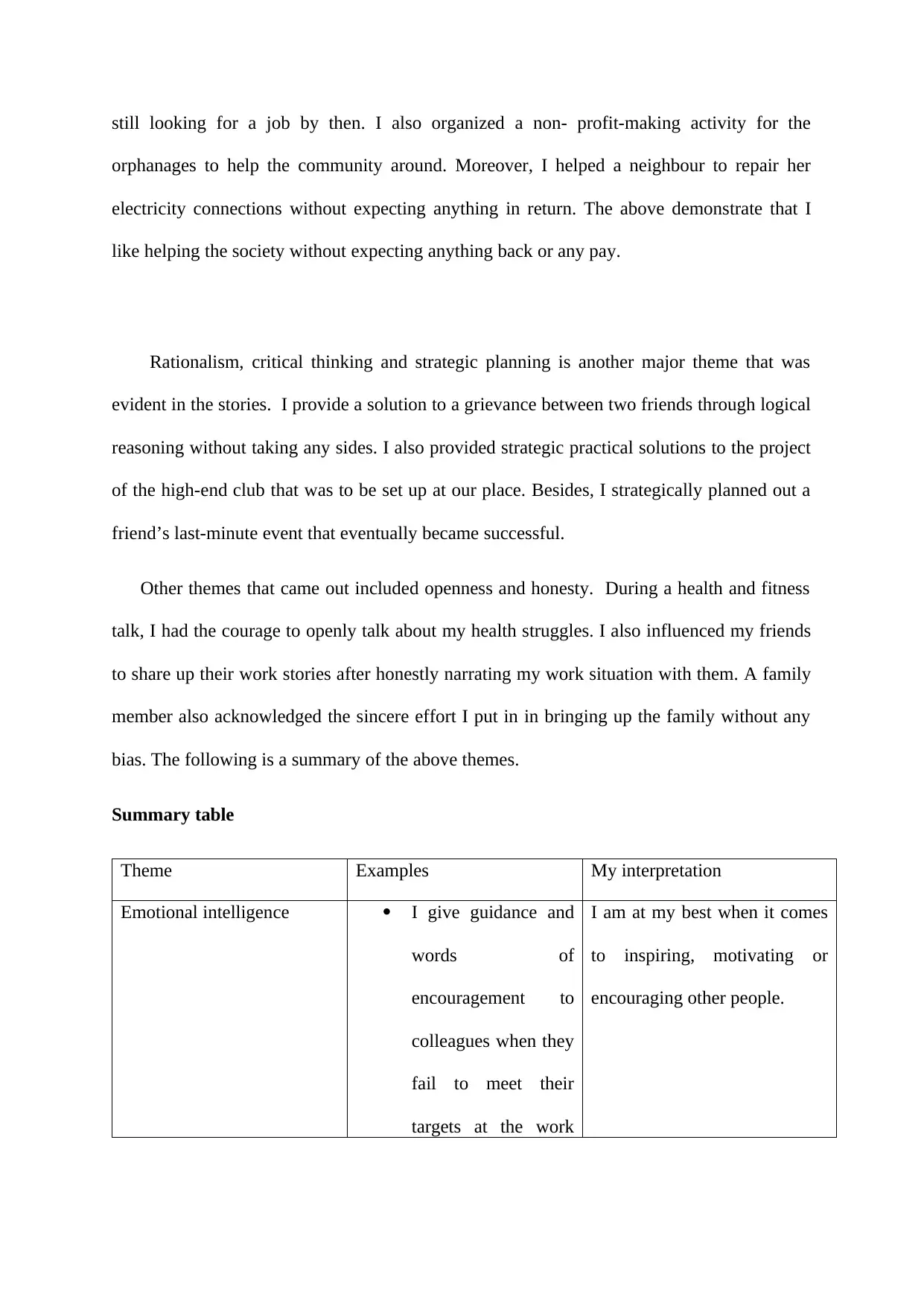
still looking for a job by then. I also organized a non- profit-making activity for the
orphanages to help the community around. Moreover, I helped a neighbour to repair her
electricity connections without expecting anything in return. The above demonstrate that I
like helping the society without expecting anything back or any pay.
Rationalism, critical thinking and strategic planning is another major theme that was
evident in the stories. I provide a solution to a grievance between two friends through logical
reasoning without taking any sides. I also provided strategic practical solutions to the project
of the high-end club that was to be set up at our place. Besides, I strategically planned out a
friend’s last-minute event that eventually became successful.
Other themes that came out included openness and honesty. During a health and fitness
talk, I had the courage to openly talk about my health struggles. I also influenced my friends
to share up their work stories after honestly narrating my work situation with them. A family
member also acknowledged the sincere effort I put in in bringing up the family without any
bias. The following is a summary of the above themes.
Summary table
Theme Examples My interpretation
Emotional intelligence I give guidance and
words of
encouragement to
colleagues when they
fail to meet their
targets at the work
I am at my best when it comes
to inspiring, motivating or
encouraging other people.
orphanages to help the community around. Moreover, I helped a neighbour to repair her
electricity connections without expecting anything in return. The above demonstrate that I
like helping the society without expecting anything back or any pay.
Rationalism, critical thinking and strategic planning is another major theme that was
evident in the stories. I provide a solution to a grievance between two friends through logical
reasoning without taking any sides. I also provided strategic practical solutions to the project
of the high-end club that was to be set up at our place. Besides, I strategically planned out a
friend’s last-minute event that eventually became successful.
Other themes that came out included openness and honesty. During a health and fitness
talk, I had the courage to openly talk about my health struggles. I also influenced my friends
to share up their work stories after honestly narrating my work situation with them. A family
member also acknowledged the sincere effort I put in in bringing up the family without any
bias. The following is a summary of the above themes.
Summary table
Theme Examples My interpretation
Emotional intelligence I give guidance and
words of
encouragement to
colleagues when they
fail to meet their
targets at the work
I am at my best when it comes
to inspiring, motivating or
encouraging other people.
⊘ This is a preview!⊘
Do you want full access?
Subscribe today to unlock all pages.

Trusted by 1+ million students worldwide
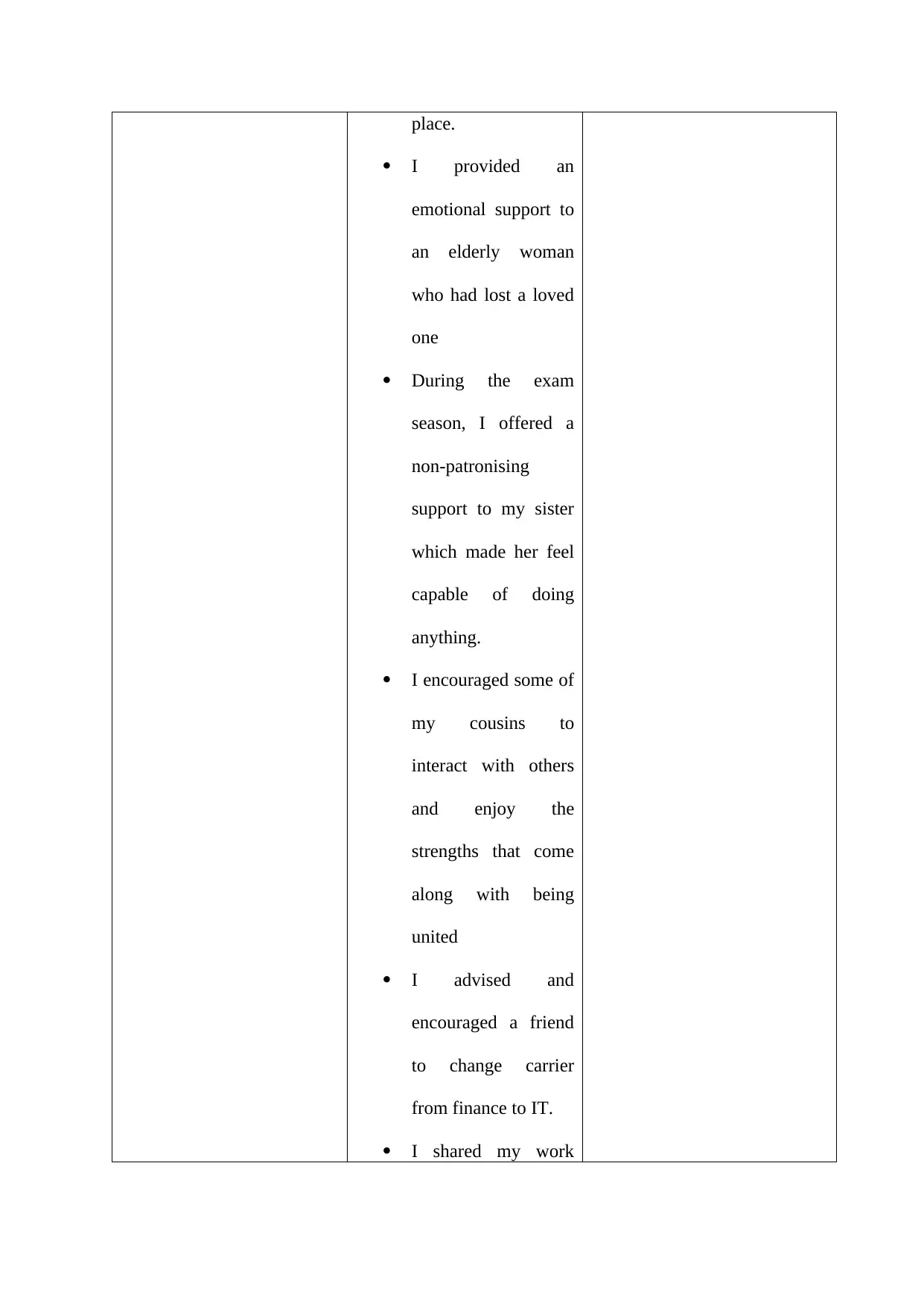
place.
I provided an
emotional support to
an elderly woman
who had lost a loved
one
During the exam
season, I offered a
non-patronising
support to my sister
which made her feel
capable of doing
anything.
I encouraged some of
my cousins to
interact with others
and enjoy the
strengths that come
along with being
united
I advised and
encouraged a friend
to change carrier
from finance to IT.
I shared my work
I provided an
emotional support to
an elderly woman
who had lost a loved
one
During the exam
season, I offered a
non-patronising
support to my sister
which made her feel
capable of doing
anything.
I encouraged some of
my cousins to
interact with others
and enjoy the
strengths that come
along with being
united
I advised and
encouraged a friend
to change carrier
from finance to IT.
I shared my work
Paraphrase This Document
Need a fresh take? Get an instant paraphrase of this document with our AI Paraphraser
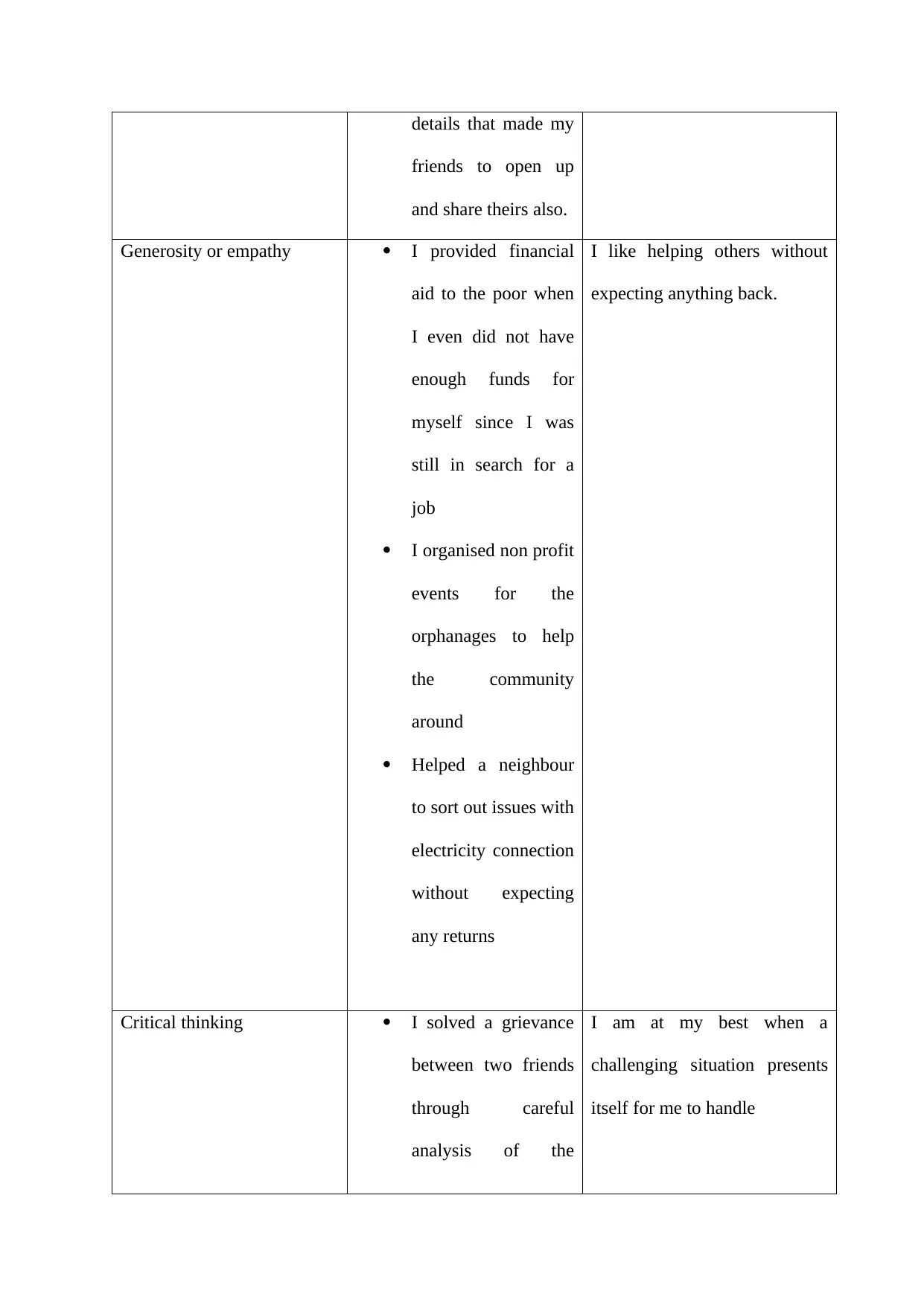
details that made my
friends to open up
and share theirs also.
Generosity or empathy I provided financial
aid to the poor when
I even did not have
enough funds for
myself since I was
still in search for a
job
I organised non profit
events for the
orphanages to help
the community
around
Helped a neighbour
to sort out issues with
electricity connection
without expecting
any returns
I like helping others without
expecting anything back.
Critical thinking I solved a grievance
between two friends
through careful
analysis of the
I am at my best when a
challenging situation presents
itself for me to handle
friends to open up
and share theirs also.
Generosity or empathy I provided financial
aid to the poor when
I even did not have
enough funds for
myself since I was
still in search for a
job
I organised non profit
events for the
orphanages to help
the community
around
Helped a neighbour
to sort out issues with
electricity connection
without expecting
any returns
I like helping others without
expecting anything back.
Critical thinking I solved a grievance
between two friends
through careful
analysis of the
I am at my best when a
challenging situation presents
itself for me to handle
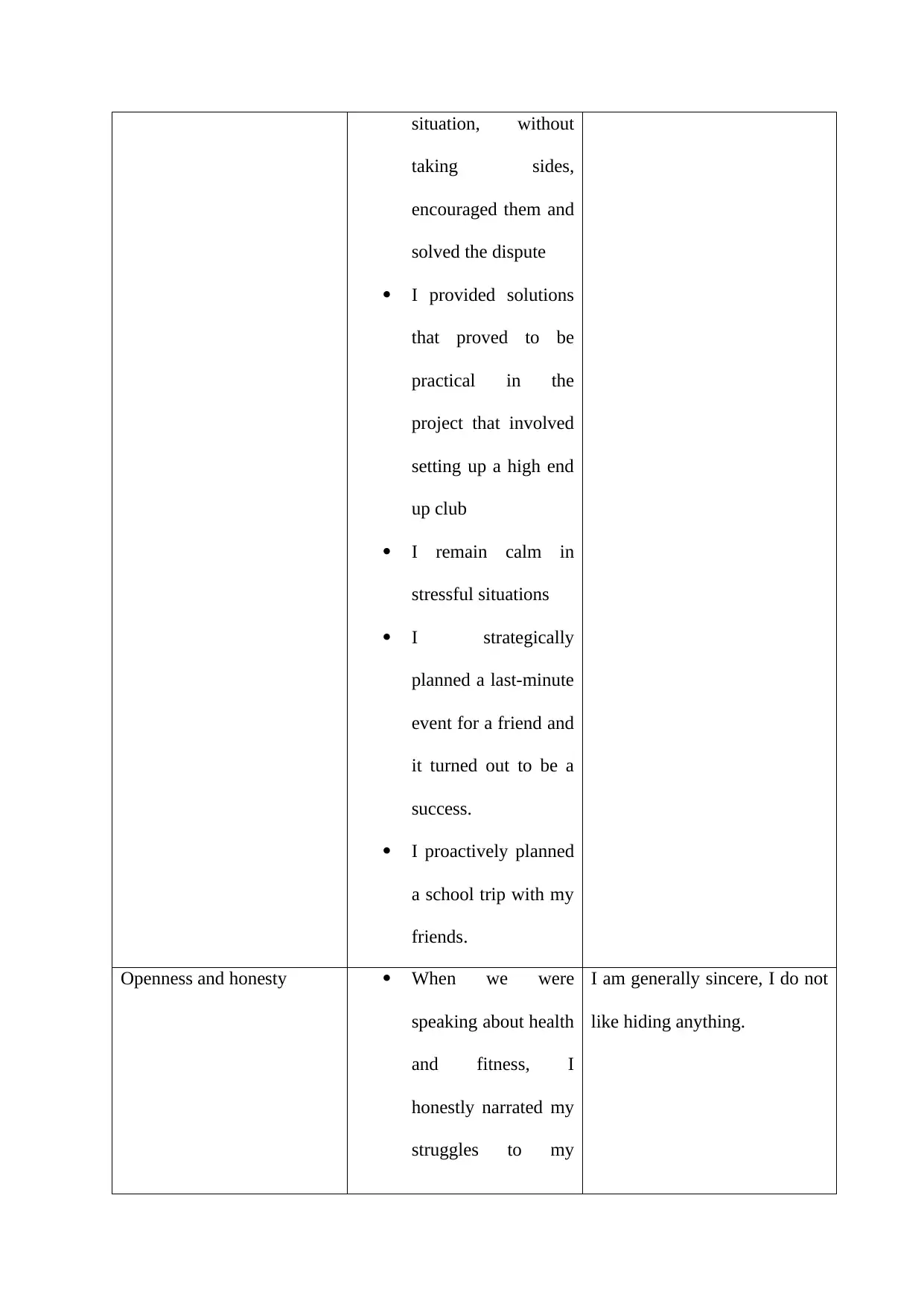
situation, without
taking sides,
encouraged them and
solved the dispute
I provided solutions
that proved to be
practical in the
project that involved
setting up a high end
up club
I remain calm in
stressful situations
I strategically
planned a last-minute
event for a friend and
it turned out to be a
success.
I proactively planned
a school trip with my
friends.
Openness and honesty When we were
speaking about health
and fitness, I
honestly narrated my
struggles to my
I am generally sincere, I do not
like hiding anything.
taking sides,
encouraged them and
solved the dispute
I provided solutions
that proved to be
practical in the
project that involved
setting up a high end
up club
I remain calm in
stressful situations
I strategically
planned a last-minute
event for a friend and
it turned out to be a
success.
I proactively planned
a school trip with my
friends.
Openness and honesty When we were
speaking about health
and fitness, I
honestly narrated my
struggles to my
I am generally sincere, I do not
like hiding anything.
⊘ This is a preview!⊘
Do you want full access?
Subscribe today to unlock all pages.

Trusted by 1+ million students worldwide
1 out of 22
Your All-in-One AI-Powered Toolkit for Academic Success.
+13062052269
info@desklib.com
Available 24*7 on WhatsApp / Email
![[object Object]](/_next/static/media/star-bottom.7253800d.svg)
Unlock your academic potential
Copyright © 2020–2025 A2Z Services. All Rights Reserved. Developed and managed by ZUCOL.

